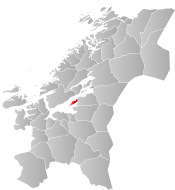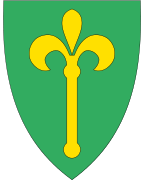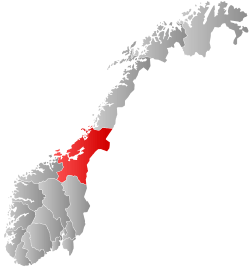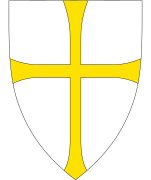Frosta
| Frosta kommune | |||
|---|---|---|---|
| Municipality | |||
 Frosta seen from Hellan looking towards Trondheim | |||
| |||
 Frosta within Trøndelag | |||
| Coordinates: 63°36′14″N 10°46′28″E / 63.60389°N 10.77444°ECoordinates: 63°36′14″N 10°46′28″E / 63.60389°N 10.77444°E | |||
| Country | Norway | ||
| County | Trøndelag | ||
| Established | 1 Jan 1838 | ||
| Administrative centre | Frosta | ||
| Government | |||
| • Mayor (2015) | Trine Haug (Sp) | ||
| Area | |||
| • Total | 76.32 km2 (29.47 sq mi) | ||
| • Land | 74.28 km2 (28.68 sq mi) | ||
| • Water | 2.04 km2 (0.79 sq mi) 2.7% | ||
| Area rank | #393 in Norway | ||
| Population (2017) | |||
| • Total | 2,630 | ||
| • Rank | #285 in Norway | ||
| • Density | 35.4/km2 (92/sq mi) | ||
| • Change (10 years) | 6.9% | ||
| Demonym(s) | Frosting[1] | ||
| Time zone | UTC+01:00 (CET) | ||
| • Summer (DST) | UTC+02:00 (CEST) | ||
| ISO 3166 code | NO-5036 | ||
| Official language form | Neutral | ||
| Website |
frosta | ||
Frosta is the smallest municipality in Trøndelag county, Norway. The administrative centre is the village of Frosta. The municipality is located along the Trondheimsfjord, on the Frosta peninsula, just north of the city of Trondheim. It also includes the island of Tautra which is connected to the mainland by a causeway bridge.
The 76-square-kilometre (29 sq mi) municipality is the 393rd largest by area out of the 422 municipalities in Norway. Frosta is the 285th most populous municipality in Norway with a population of 2,630. The municipality's population density is 35.4 inhabitants per square kilometre (92/sq mi) and its population has increased by 6.9% over the last decade.[2]
General information
Frosta was established as a municipality on 1 January 1838 (see formannskapsdistrikt). It is one of very few municipalities in Norway with unchanged borders since that date.[3] In 2018, the municipality, which was part of the old Nord-Trøndelag county became part of the new Trøndelag county.
Name
The Old Norse form of the name was (also) Frosta. The meaning of the name is unknown. Historically, the name was also spelled Frosten.[4]
Coat of arms
The coat of arms are relatively modern; they were granted on 26 June 1987. The arms show a gold sceptre or mace on a green background. The coat of arms was inspired by the old seal of the medieval Frostating assembly, where King Magnus VI the law-mender is sitting with a lily sceptre in his hand. Frosta was one of the historic places of justice, so this was chosen to commemorate that fact.[5][6]
Churches
The Church of Norway has one parish (sokn) within the municipality of Frosta. It is part of the Sør-Innherad prosti (deanery) in the Diocese of Nidaros.
| Parish (Sokn) | Church Name | Location of the Church | Year Built |
|---|---|---|---|
| Frosta | Frosta Church | Frosta | 1866 |
| Logtun Church | Logtun | 16th century |
History

Several rock engraving sites can be found in the parish, together with burial mounds from Viking times. Archaeologists have for the first time found the remnants of a Viking harbour (Vikinghavna på Fånestangen) in Norway at Frosta. A number of logs sticking up along the shoreline at Frosta have been dated back to around year 1000.
Norway's oldest court, Frostating, had its seat here at Tinghaugen, close to the mediaeval church at Logtun. On the island of Tautra can be found the remains of Tautra Abbey, a Trappist (Reformed Cistercian) convent, established in 1207.
Government
All municipalities in Norway, including Frosta, are responsible for primary education (through 10th grade), outpatient health services, senior citizen services, unemployment and other social services, zoning, economic development, and municipal roads. The municipality is governed by a municipal council of elected representatives, which in turn elect a mayor. The municipality falls under the Inntrøndelag District Court and the Frostating Court of Appeal.
Municipal council
The municipal council (Kommunestyre) of Frosta is made up of 17 representatives that are elected to four year terms. Currently, the party breakdown is as follows:[7]
| Party Name | Name in Norwegian | Number of representatives | |
|---|---|---|---|
| Labour Party | Arbeiderpartiet | 3 | |
| Conservative Party | Høyre | 4 | |
| Christian Democratic Party | Kristelig Folkeparti | 1 | |
| Centre Party | Senterpartiet | 6 | |
| Socialist Left Party | Sosialistisk Venstreparti | 1 | |
| Liberal Party | Venstre | 2 | |
| Total number of members: | 17 | ||
Economy
Agriculture makes up the largest business in Frosta, which is sometimes called "Trondheim's kitchen garden" due to the substantial production of vegetables, strawberries, and flowers.
Notable residents
- Anna Ceselie Brustad Moe, politician for the Centre Party
- Lars Myraune, military leader and politician
- Karin Pettersen, team handball player and Olympic medalist
- Vidar Riseth, former football player
References
- ↑ "Navn på steder og personer: Innbyggjarnamn" (in Norwegian). Språkrådet. Retrieved 2015-12-01.
- ↑ Statistisk sentralbyrå (2017). "Table: 06913: Population 1 January and population changes during the calendar year (M)" (in Norwegian). Retrieved 2017-09-26.
- ↑ Jukvam, Dag (1999). "Historisk oversikt over endringer i kommune- og fylkesinndelingen" (PDF) (in Norwegian). Statistisk sentralbyrå.
- ↑ Rygh, Oluf (1903). Norske gaardnavne: Nordre Trondhjems amt (dokpro.uio.no) (in Norwegian) (15 ed.). Kristiania, Norge: W. C. Fabritius & sønners bogtrikkeri. p. 62.
- ↑ "Nord-Trøndelag fylke" (in Norwegian). Retrieved 2008-10-29.
- ↑ "Civic heraldry of Norway - Norske Kommunevåpen". Heraldry of the World. Retrieved 2018-03-29.
- ↑ "Table: 04813: Members of the local councils, by party/electoral list at the Municipal Council election (M)" (in Norwegian). Statistics Norway. 2015.
External links
| Wikimedia Commons has media related to Frosta. |

- Municipal fact sheet from Statistics Norway (in Norwegian)
- Turist information (in Norwegian)
- Local newspaper (in Norwegian)
- Tautra Cistercian abbey
- Municipal main page (in Norwegian)
- The international Frosta festival (in Norwegian)
- Hauganfjæra Camping (in Norwegian)


